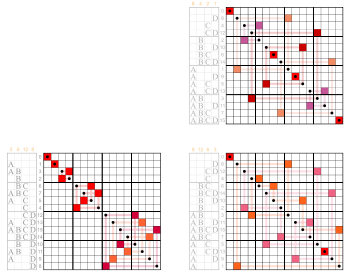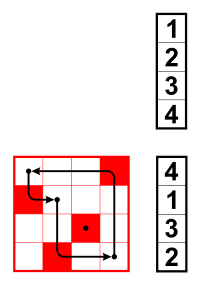- Cycles and fixed points
-
 16-bit Gray code permutation G
16-bit Gray code permutation G
multiplied with the bit-reversal permutation B
G has 2 fixed points, 1 2-cycle and 3 4-cycles
B has 4 fixed points and 6 2-cycles
GB has 2 fixed points and 2 7-cyclesIn combinatorial mathematics, the cycles of a permutation π of a finite set S correspond bijectively to the orbits of the subgroup generated by π acting on S. These orbits are subsets of S that can be written as { c1, ..., cl }, such that
- π(ci) = ci + 1 for i = 1, ..., l − 1, and π(cl) = c1.
The corresponding cycle of is π written as ( c1 c2 ... cn ); this expression is not unique since c1 can be chosen to be any element of the orbit.
The size l of the orbit is called the length of the corresponding cycle; when l = 1, the cycle is called a fixed point. In counting the fixed points among the cycles of a permutation, the combinatorial notion of cycle differs from the group theoretical one, where a cycle is a permutation in itself, and its length cannot be 1 (even if that were allowed, this would not suffice to distinguish different fixed points, since any cycle of length 1 would be equal to the identity permutation).
A permutation is determined by giving an expression for each of its cycles, and one notation for permutations consist of writing such expressions one after another in some order. For example, let
be a permutation that maps 1 to 2, 6 to 8, etc. Then one may write
- π = ( 1 2 4 3 ) ( 5 ) ( 6 8 ) (7) = (7) ( 1 2 4 3 ) ( 6 8 ) ( 5 ) = ( 4 3 1 2 ) ( 8 6 ) ( 5 ) (7) = ...
Here 5 an 7 are fixed points of π, since π(5)=5 and π(7)=7. This kind of expression resembles the group-theoretic decomposition of a permutation as a product of cycles with disjoint orbits, but in that decomposition the fixed points do not appear.
There are different ways to write a permutation as a list of its cycles, but the number of cycles and their contents are given by the partition of S into orbits, and these are therefore the same for all such expressions. The cycle structure of a permutation is the partition of the size of S obtained by listing the lengths of the cycles (including a part 1 for each fixed point) in weakly decreasing order. The cycle structure of finite permutations is denoted by the elements of sequence
 A198380.
A198380.Contents
Counting permutations by number of cycles
The unsigned Stirling number of the first kind, s(k, j) counts the number of permutations of k elements with exactly j disjoint cycles.
Properties
- (1) For every k > 0 : s(k, k) = 1.
- (2) For every k > 0 : s(k, 1) = (k − 1)!.
- (3) For every k > j > 1, s(k, j) = s(k − 1,j − 1) + s(k − 1, j)·(k − 1)
Reasons for properties
- (1) There is only one way to construct a permutation of k elements with k cycles: Every cycle must have length 1 so every element must be a fixed point.
-
- (2.a) Every cycle of length k may be written as permutation of the number 1 to k; there are k! of these permutations.
-
- (2.b) There are k different ways to write a given cycle of length k, e.g. ( 1 2 4 3 ) = ( 2 4 3 1 ) = ( 4 3 1 2 ) = ( 3 1 2 4 ).
-
- (2.c) Finally: s(k, 1) = k!/k = (k − 1)!.
- (3) There are two different ways to construct a permutation of k elements with j cycles:
-
- (3.a) If we want element k to be a fixed point we may choose one of the s(k − 1, j − 1) permutations with k − 1 elements and j − 1 cycles and add element k as a new cycle of length 1.
-
- (3.b) If we want element k not to be a fixed point we may choose one of the s(k − 1, j ) permutations with k − 1 elements and j cycles and insert element k in an existing cycle in front of one of the k − 1 elements.
Some values
k j 1 2 3 4 5 6 7 8 9 sum 1 1 1 2 1 1 2 3 2 3 1 6 4 6 11 6 1 24 5 24 50 35 10 1 120 6 120 274 225 85 15 1 720 7 720 1,764 1,624 735 175 21 1 5,040 8 5,040 13,068 13,132 6,769 1,960 322 28 1 40,320 9 40,320 109,584 118,124 67,284 22,449 4,536 546 36 1 362,880 1 2 3 4 5 6 7 8 9 sum Counting permutations by number of fixed points
The value f(k, j) counts the number of permutations of k elements with exactly j fixed points. For the main article on this topic, see rencontres numbers.
Properties
- (1) For every j < 0 or j > k : f(k, j) = 0.
- (2) f(0, 0) = 1.
- (3) For every k > 1 and k ≥ j ≥ 0, f(k, j) = f(k − 1, j − 1) + f(k − 1, j)·(k − 1 − j) + f(k − 1, j + 1)·(j + 1)
Reasons for properties
(3) There are three different methods to construct a permutation of k elements with j fixed points:
- (3.a) We may choose one of the f(k − 1, j − 1) permutations with k − 1 elements and j − 1 fixed points and add element k as a new fixed point.
- (3.b) We may choose one of the f(k − 1, j) permutations with k − 1 elements and j fixed points and insert element k in an existing cycle of length > 1 in front of one of the (k − 1) − j elements.
- (3.c) We may choose one of the f(k − 1, j + 1) permutations with k − 1 elements and j + 1 fixed points and join element k with one of the j + 1 fixed points to a cycle of length 2.
Some values
k j 0 1 2 3 4 5 6 7 8 9 sum 1 0 1 1 2 1 0 1 2 3 2 3 0 1 6 4 9 8 6 0 1 24 5 44 45 20 10 0 1 120 6 265 264 135 40 15 0 1 720 7 1,854 1,855 924 315 70 21 0 1 5,040 8 14,833 14,832 7,420 2,464 630 112 28 0 1 40,320 9 133,496 133,497 66,744 22,260 5,544 1,134 168 36 0 1 362,880 0 1 2 3 4 5 6 7 8 9 sum Alternate calculations
Example: f(5, 1) = 5×1×4! − 10×2×3! + 10×3×2! - 5×4×1! + 1×5×0!
- = 120 - 120 + 60 - 20 + 5 = 45.
Example: f(5, 0) = 120 - ( 5×4! - 10×3! + 10×2! - 5×1! + 1×0! )
- = 120 - ( 120 - 60 + 20 - 5 + 1 ) = 120 - 76 = 44.
- For every k > 1:
-
- f(k,0) = (k − 1)(f(k − 1,0) + f(k − 2,0))
Example: f(5, 0) = 4 × ( 9 + 2 ) = 4 × 11 = 44
- For every k > 1:
Example: f(5, 0) = 120 × ( 1/2 - 1/6 + 1/24 - 1/120 )
- = 120 × ( 60/120 - 20/120 + 5/120 - 1/120 ) = 120 × 44/120 = 44
- where e is Euler's number ≈ 2.71828
See also
Categories:- Permutations
- Fixed points
Wikimedia Foundation. 2010.






